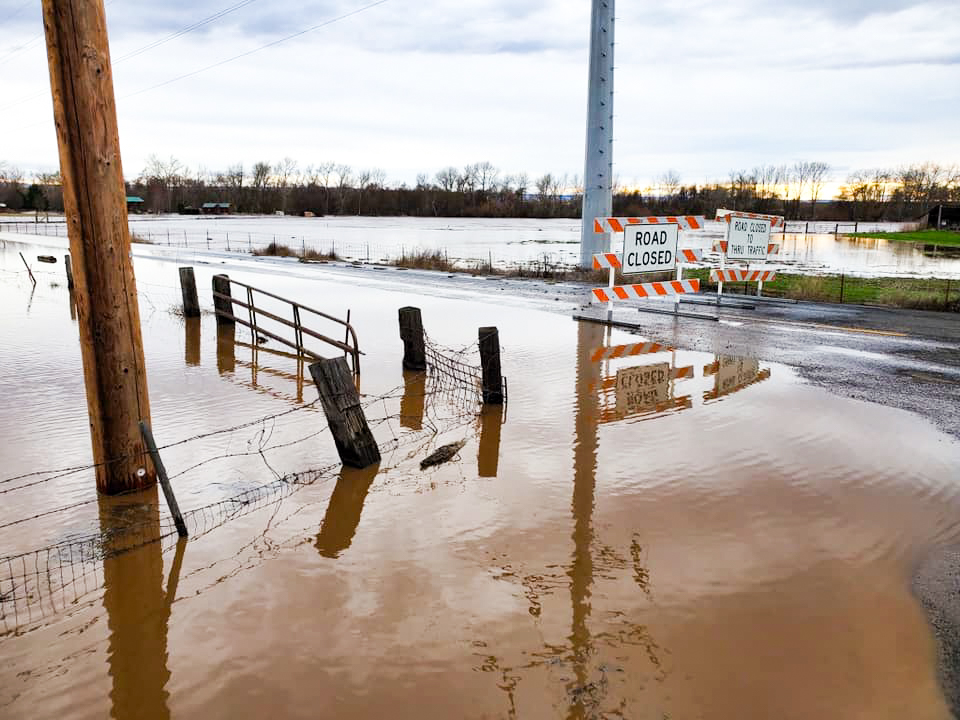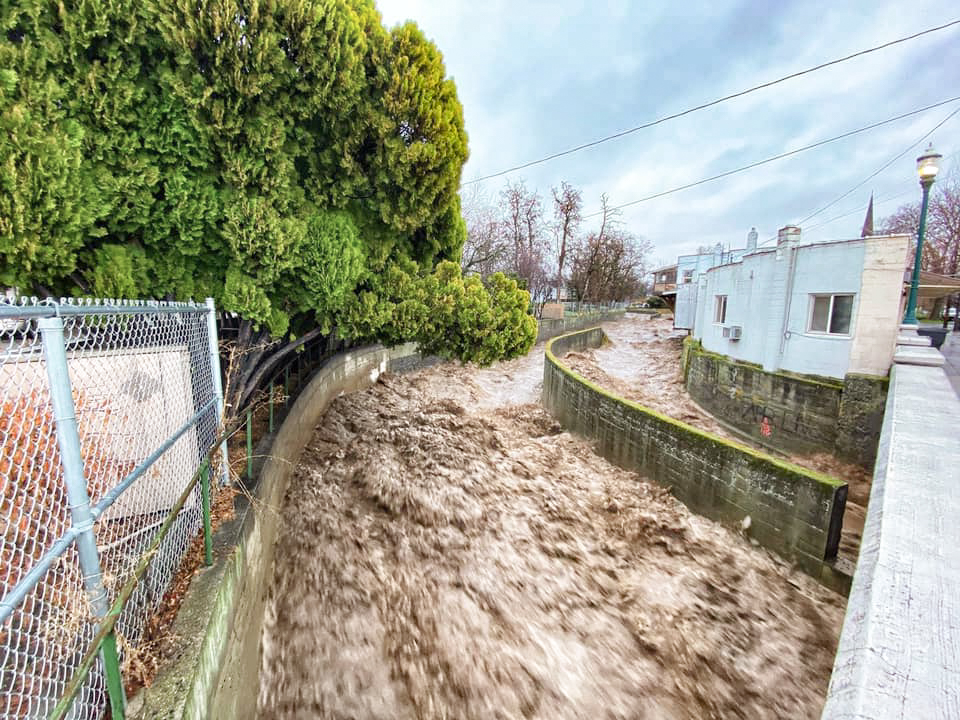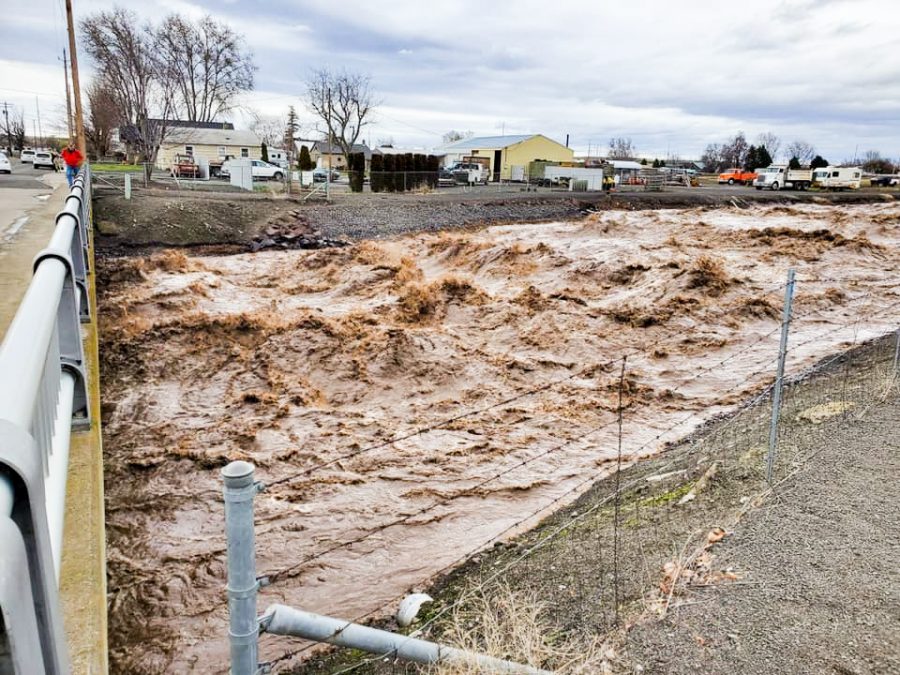Walla Walla Valley sustains damage from flooding
The Walla Walla Valley was heavily impacted by flooding. While downtown Walla Walla was unharmed, there was damage in Waitsburg, Upper Mill Creek, Pendleton and the Umatilla Indian Reservation. Photos contributed by Andrew Kinney
February 20, 2020
Walla Walla County experienced immense flooding beginning Thursday, Feb. 6, following days of constant rainfall.
Ki Bealey, the public works director for the City of Walla Walla, described the events that unfolded surrounding the flooding. Bealey informed The Wire that, on Feb. 6, the city dispatched crews to unclog culverts up Mill Creek Road – the location of the water intake facility that treats the city’s drinking water. The crews’ efforts were unsuccessful and the facility was evacuated. These clogged culverts were the first point of impact.
Bealey described the events following.
“Friday morning, I received the first call at 2:30 … in the morning that the corps was going to ramp up how much water they put through the city of Walla Walla through the main channel,” Bealey said. “We dispatched 11 teams of two to go and check bridges, observe the levys through town and to report findings back to our office on any actions that needed to be taken.”
The Roosevelt Bridge, Otis Bridge, Marion Bridge and Sixth Avenue Bridge were closed due to structural concerns at that time. By then, there was widespread damage in Waitsburg, Upper Mill Creek, the upper parts north and south of the Walla Walla Valley, Pendleton, the Umatilla Indian Reservation, the headwaters of the Umatilla River and along the highways that go over the Blue Mountains through Tollgate.

On Saturday, Feb. 8, additional teams came in to review what had been observed on Friday as the situation started to calm down. Two more bridge closures took place. These same teams checked the bridges on Sunday and Monday morning to evaluate the conditions and see if reopening was an option.
The most significant damage sustained was not directly in the city of Walla Walla, but stemmed from the washing out of the 1,400 feet of the main transmission water line in Mill Creek Road.
Mayor Tom Scribner shared information about the city’s changes, including that the city is now using seven wells as its water source rather than the Mill Creek watershed. Mayor Scribner continued to discuss the damage done up Mill Creek Road.
“That is going to take some time — months and months — to repair and replace,” Mayor Scribner said. “It’s going to cost — these are early estimates — several million dollars.”
The Mill Creek Coalition is a group of individuals representing the city of Walla Walla, Walla Walla County, the Port of Walla Walla, the downtown business community and other entities. The group is another governing factor influencing the future of the channel. The group formed over concern of flooding in the city and of the conditions of the existing channel, which is almost eighty years old.
The Mill Creek Coalition has reached out to the state and federal government to get funding to study what can be done to improve the channel through town. The federal government approved three million dollars for a three year study, conducted by the corps of engineers, for the structural integrity of the channel.
The plan prepared by the corps is not finalized. As of Wednesday, Feb. 3, the corps’ proposal is that the channel will remain in its present location and portions of it will be rebuilt. The channel’s ability to handle up to about 4,000 cubic feet per second of water will remain.
On Feb. 12, the city council passed an ordinance declaring a state of emergency due to the flooding. This authorized the city to make an application for federal funds and/or state funds to pay for the cost of these repairs.

Flooding almost occurred in the city of Walla Walla itself. Mayor Scribner described how these floods were prevented.
“Bennington Lake reached 80 percent storage capacity. Had it rained for another day or two … the corps of engineers would have reached a point where Bennington Lake probably couldn’t have taken any more water,” Mayor Scribner said. “They would’ve needed to release potentially up to 6,000 cubic feet per second… through Walla Walla, in which case the channel wouldn’t have held that water and we would’ve had flooding downtown.”
Kevin Pogue, a geology professor at Whitman, added his point of view on the city’s ability to adapt to flooding.
“The flood control project worked exactly as it was supposed to and that prevented the kind of catastrophe we had here in 1931,” Pogue said. “A lot of people, myself included, despise the aesthetics of the concrete ditch throughout town, but the fact of the matter is it worked exactly as it’s supposed to.”
At Whitman, the science department has been involved with the issue by participating in outreach. The department has discussed hosting an open forum where the cause and effects of the flooding issue will be explained.
Pogue discussed the science community’s impact on events like this flooding and other natural disasters.
“As a society, we tend to ignore the risks that are sometimes obvious to some of us in the science community. We call a floodplain a floodplain for a reason because the definition… is the plain on which the river floods,” Pogue said. “I think the best thing we can do is educate.”
Pogue has also been extensively involved with the Department of Atmospheric Sciences at the University of Washington, alerting them about the conditions in Walla Walla. He specifically worked with Cliff Mass, a weather blogger for the Pacific Northwest, who created a post featuring the Walla Walla area’s flood with Pogue’s slides.
Bealey talked about the recovery steps that might need to be taken in the future.
“What may happen, and this is a thought for the future, is … we could be on well water for an extended period of time,” Bealey said. “We may need to do some conservation on water usage because although we have a robust well system, some of the wells don’t taste as good as others, and so we may need some level of conservation at that time.”







Gene Spangrude • Mar 18, 2020 at 6:54 am
‘Channel and Floodplain aesthetics’ are definitely an important issue here.
Hopefully a ‘Field Trip’ can be arranged in Spring 2020 to look at the ‘Post Flood Floodplain Aesthetics’ of the Walla Walla River upstream of Milton-Freewater, Oregon; and Mill Creek upstream of Walla Walla, Washington.
And then conclude the ‘Field Trip’ by looking at Mill Creek’s Post Flood Floodplain Aesthetics between the Tausick Way Bridge and the Ninth Street Bridge over Mill Creek…….
Hopefully some differences in ‘Post Flood Floodplain Aesthetics’ will be noted from taking this Field Trip……
Hopefully the question of ‘aesthetics’ can be better addressed after taking this Field Trip……